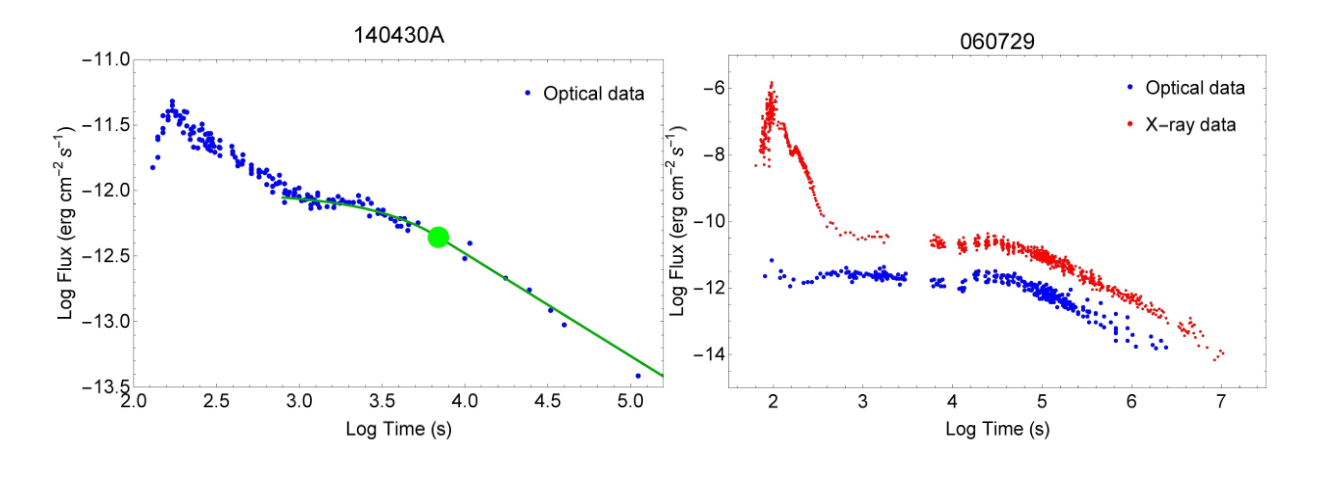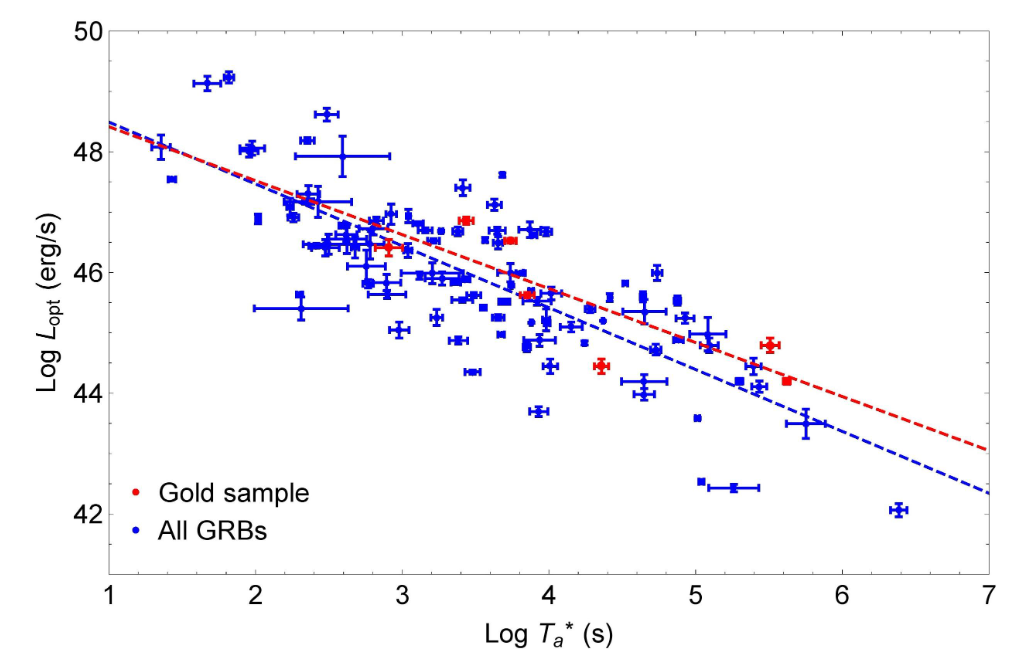Astronomy Object of the Month: 2021, January
< previous Archive next >
Optical Luminosity-Time correlation for more than 100 GRBs
A new correlation has been discovered in optical observations of gamma-ray bursts (GRBs) that
may be the key to using GRBs as cosmological distance indicators. Under Dr. Dainotti
mentorship (KIPAC alum, Assistant Professor at Jagiellonian University in Poland and
Senior Research Scientist at the RIKEN iTHEMs in Japan and affiliated senior resear h scientist
at Space Science Institute), Samantha Livermore (fourth-year physics major at Tufts
University) investigated the “plateau emission” in optical GRB observations during Samantha’s
internship at SLAC National Accelerator Laboratory and Stanford University through the
SULI program during the summer of 2020. The work continued afterwards during Livermore’s thesis research until its publication.
Dainotti and Livermore worked with a large team of international collaborators located in US,
Europe, Mexico and Australia to gather a sizable sample and conduct their rigorous statistical
analysis. This research, a continuation of Dr. Dainotti’s previous work on the plateau emission of
GRBs, features the largest sample of optical plateaus in the literature to date, and has been
accepted to be published in the Astrophysical Journal Letters.

The “plateau emission”, a feature commonly found in X-ray observations of GRBs, has been the subject of much study in the GRB community in recent years. This feature takes place after the initial prompt emission of the GRB, and is followed by a steadily decaying afterglow as the GRB fades away. The most interesting features of the plateau emission, however, are the luminosity and time at which the plateau ends. These parameters make up the luminosity-time correlation in X-rays, which states that in log-log space, there is an anticorrelation between the luminosity and the time at the end of the plateau emission in X-ray observations of GRBs (Dainotti et al. 2008). This correlation has been tested against selection biases in collaboration with Professor Petrosian at Stanford University. Thus, encouraged by the intrinsic nature of this correlation, in this most recent work, Dainotti and Livermore find that this luminosity-time correlation also holds in optical observations, extending the correlation and its implications further across the electromagnetic spectrum.
The team studied 267 optical GRB light curves (mostly from the Neil Gehrels Swift Observatory) and found that 102 of them had well-defined plateaus by fitting the curves with a phenomenological model known as the Willingale model, shown in the left panel of Fig. 1. Once the plateaus are identified, the luminosity-time parameters of each GRB are gathered for a large statistical analysis. When the luminosity-time data is plotted for the entire sample, it is clear that the luminosity-time correlation could also be found in optical plateaus, as well as X-ray plateaus as had been shown previously (this correlation has a clear slope of -1 in log luminosity- log time space). This means that the more luminous the optical plateau, the shorter its duration. Given the slope of the correlation is nearly -1, this further supports that the plateau has a fixed energy reservoir independent of a given class and a possible explanation can be the magnetar model. The source of the dispersion of the correlation comes both from a physical point of view, depending on the energy mechanism underlying the plateau, and from an instrumental point of view.
Not only was the familiar X-ray correlation reproduced in optical observations, but the correlation was found to be constant even in different sub-samples of GRBs. When the 102 GRBs were divided by classification, and plateau inclination, the correlation did not vary significantly, showing that the optical luminosity-time correlation holds across a varied population of GRBs.
This correlation implies that the energy reservoir of the GRB is constant during the plateau emission, which aids astrophysicists in unifying a large and varied population of GRB events. It is an extremely interesting and challenging task to standardize groups of GRBs in order to take advantage of their incredible luminosity and use them as standard candles. GRBs have been observed up to redshifts of z ≈ 8.2, making them attractive candidates for use as cosmological distance indicators, since they reach further back in time than the current most popular standard candles, Supernova Ia, observed up to z < 2.3.


The problem, however, is that GRB varies in duration, brightness, progenitor system, and morphological features. In order to use GRBs to measure distances in the universe, we need better understand their emission mechanisms and find features that unite their larger population —this is why the existence of the luminosity-time correlation in optical plateaus is so crucial. Looking at relationships between observable parameters of the plateau helps to define intrinsic patterns that could unify a diverse population of GRBs.
The main finding of the paper is that the Gold Sample, defined as the GRBs with almost relatively flat plateaus and at least with 5 points at the beginning of the plateau itself, has a reduced dispersion around the best fit line which is 52.4% smaller than the whole sample. The slopes of the X-ray and optical luminosity-time correlation are comparable within 1σ. The researchers were able to obtain a reduced scatter when considering light curves belonging to the Gold Sample.
Original publication: M.G. Dainotti, S. Livermore, D.A. Kann, L. Li, S. Oates, S. Yi, B. Zhang, B. Gendre, B. Cenko, N. Fraija: The Optical Luminosity-Time Correlation for More Than 100 Gamma-Ray Burst Afterglows, ApJS, 238, 9, 2018.
Presented results are a part of research conducted at the Department of High Energy Astrophysics of the Jagiellonian University’s Astronomical Observatory.
|
Maria Giovanna Dainotti Astronomical Observatory Jagiellonian University M.Dainotti [at] oa.uj.edu.pl |


